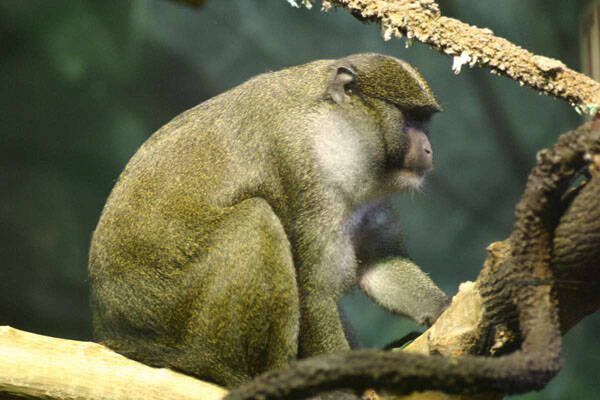Allenopithecus nigroviridis
IUCN
LCBasic Information
Scientific classification
- name:Allenopithecus nigroviridis
- Scientific Name:Allenopithecus nigroviridis,Allen's Swamp Monkey,Dark green long-tailed monkey
- Outline:Primates
- Family:Cercopithecidae Brachycera
Vital signs
- length:40-60cm
- Weight:3.5-6kg
- lifetime:About 23 years
Feature
It looks quite sturdy, and its skeleton is somewhat similar to that of a baboon.
Distribution and Habitat
The short-limbed monkey is found in Cameroon, Congo, and the Democratic Republic of Congo. It is concentrated in the lowland forests of the central Congo Basin to the Democratic Republic of Congo (on both sides of the Congo River), Cameroon, and Congo. It has also been recorded on two islands near the village of Bomasa on the Sangha River. It is basically restricted to from about 16°-27°E, about 3°N to 6°30'S. It is also found in northeastern Angola (needs further confirmation).
Prefers to live in swamp forests, and has also been reported to live in riverine forest belts.
Appearance
The short-limbed monkey is a sturdy animal, quite strong in appearance, and its skeleton looks somewhat similar to that of a baboon. The body length is 40-60 cm, the tail length is about 50 cm, and the weight of males can reach 6 kg, and females can reach 3.5 kg. The cheeks are covered with long hair, and the appearance is a bit like a lion. Males are heavier than females. The hair on the head, neck and shoulders is slightly longer than that on other parts. The face is bare and hairless, with clear contours. The eye sockets are formed into a ring by bones, so that the two eyes are forward and the distance between the eyes is narrow. The vision is developed and three-dimensional, which can accurately judge the distance and distinguish colors when moving between the trees, but the sense of smell is degenerated, and the structure of the skull has also changed. The snout is prominent, the two jaws are thick, and there are 32 teeth. The tooth type is heterodontic, divided into incisors, can
Details
Allenopithecus nigroviridis (scientific name: Allen's Swamp Monkey) is the only species of the genus Allenopithecus in the family Primates.

Allenopithecus nigroviridis is a diurnal animal that forages on the ground. It lives in groups, with up to 40 monkeys in a group, and is usually divided into groups of 2-6 to find food. They communicate through calls, gestures, and physical contact. They choose places near water sources and build simple nests in trees to sleep, which they reuse. The short-limbed monkey moves through the forest on four legs. This species can swim and dive.
The short-limbed monkey's diet mainly consists of fruits and leaves, and sometimes eats beetles and worms. In the dry season, they also look for small fish in dry riverbeds to fill their stomachs. Mothers feed young monkeys with nectar.
Short-limbed monkeys usually go into heat from November to December. They give birth from March to June of the following year, or give birth to two litters in three years, with one litter per litter. The average gestation period is about 5 months, and the lactation period is about 3 months. They are sexually mature at 3-5 years old, but they participate in mating as early as 6-7 years old. The lifespan can reach up to 23 years.
The distribution range of the short-limbed monkey is wide, and it is not close to the critical value of vulnerable and endangered species survival (distribution area or fluctuation range is less than 20,000 square kilometers, habitat quality, population size, and distribution area fragmentation). The population trend is stable, so it is evaluated as a species with no survival crisis. Although there is no evidence that the survival of this species is threatened by habitat loss, it is also threatened by hunting and commercial purposes. Research on the degree of pressure caused by human hunting on short-limbed monkeys needs to be evaluated.
Listed in the 2008 Red List of Endangered Species of the World Conservation Union (IUCN) ver 3.1-Least Concern (LC).
Listed in the Appendix II of the CITES Convention on International Trade in Endangered Species.
Protect wild animals and stop eating game.
Maintaining ecological balance is everyone's responsibility!








